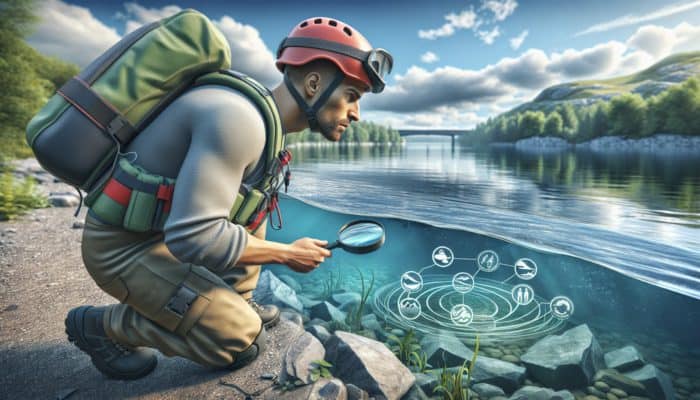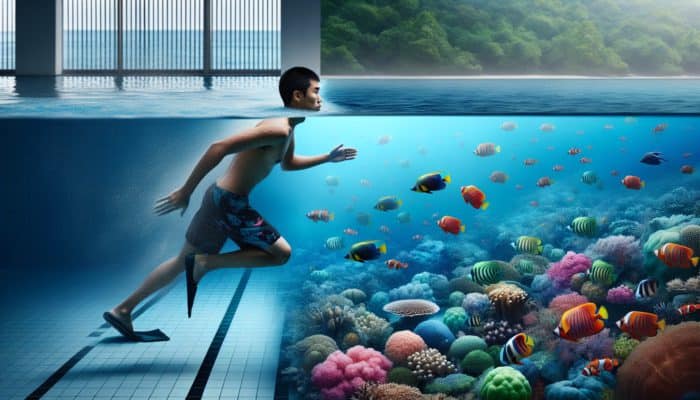Comprehensive Guide to Water Hazards and Safety
Water Safety Tips: Water is an enchanting element, inviting us to immerse ourselves and discover its mysteries. However, it also hides numerous dangers that can transform a delightful day out into a tragic event. A profound understanding of these hazards forms the basis of effective water safety tips. Each body of water—be it a tranquil lake, an expansive ocean, or a fast-flowing river—possesses distinct features and associated risks that every individual should be aware of to ensure a safe and enjoyable experience.
Recognising Potential Water Hazards

Before diving into any body of water, it is crucial to identify potential hazards that may be concealed beneath the surface. Strong currents can swiftly pull even the most skilled swimmers into perilous situations, while obstacles like rocks, debris, and sudden drop-offs present serious threats. Additionally, slippery surfaces surrounding water bodies can lead to falls, resulting in severe injuries. It is essential to thoroughly assess the environment, as this vigilance can significantly reduce the risk of accidents and ensure a safe outing.
Gaining knowledge about local water conditions is imperative for safety. For instance, beaches along the Australian coast can feature rip currents, commonly referred to as “rips,” which can be deceptive to those unaware. Similarly, freshwater lakes across the United States often conceal submerged logs and large rocks, creating a hazard. By familiarising oneself with these hazards, one can significantly reduce the chances of accidents. Always make it a point to survey your surroundings—this simple act of diligence could be the key to a safe and enjoyable water experience.
Evaluating Water Risk Levels
Water conditions are not uniform, and recognising this variety is crucial for accurately assessing risk levels. Weather conditions play a significant role in water safety; storms can result in unpredictable waves and currents, rendering swimming hazardous. For instance, the typically warm Caribbean waters can shift dramatically, becoming treacherous with sudden squalls that appear unexpectedly. Understanding these fluctuations is essential for ensuring safety during water activities.
Another critical factor to consider is water depth. Shallow areas may seem safe, but diving into unknown depths can lead to serious injuries. To evaluate your swimming abilities honestly, ask yourself: Are you at ease in deep waters, or do you prefer the shallows? Knowing your limits is vital for safety. For example, inexperienced swimmers should always remain in shallower areas and avoid venturing into deeper waters where panic can set in. Understanding your capabilities is key to enjoying water activities safely.
Empowering Others Through Education
Spreading awareness about water hazards is a vital step in fostering a culture of safety. When you educate friends and family about the potential dangers associated with water activities, you empower them to make informed choices that promote safety. Engage in discussions and look out for what to observe in various environments. For instance, when planning a family day out at the beach, emphasize the importance of locating lifeguards, reading warning signs, and understanding the area’s layout.
Including children in these conversations not only prepares them for safe experiences in the water but also reinforces their awareness of being conscious of their surroundings. When everyone involved is well-informed and vigilant, the likelihood of accidents significantly diminishes. It is about building a community focused on safety during water activities, where each crucial plays an important role in ensuring the well-being of others.
Essential Water Safety Guidelines
The excitement of splashing in pools or diving into the ocean should always be accompanied by adherence to essential water safety guidelines. These foundational rules are designed to protect individuals while nurturing a safe and enjoyable environment for all water enthusiasts.
Always Swim with a Companion
The saying “safety in numbers” holds particularly true in the context of swimming. Engaging in water activities alone poses a significant risk, as the chances of drowning increase if something goes awry. Whether navigating the waves at a Hawaiian beach or floating in a serene Swedish lake, having a swimming buddy ensures that help is immediately accessible if needed.
Establishing a buddy system during water activities can provide peace of mind. For example, if one participant encounters difficulties, the other can either assist or seek help without delay. This straightforward practice can save lives, making it imperative for everyone to commit to never swimming alone, regardless of their confidence in their swimming abilities.
Always Wear a Life Jacket
Regardless of an individual’s swimming proficiency, wearing a properly fitted life jacket during any water activity is a non-negotiable safety measure. Life jackets significantly enhance buoyancy and serve as potential lifesavers in emergencies. Whether kayaking through the currents of the Amazon River or sailing across the Mediterranean Sea, every participant should don a life jacket, particularly in unpredictable waters.
Selecting the appropriate type of life jacket for the specific activity is also crucial for individuals. For instance, those participating in water sports, such as wakeboarding, may require different life jackets compared to leisurely boaters. Prioritizing safety is not merely about compliance; it is about enjoying the experience with confidence, knowing you have an additional layer of protection at all times.
Understanding Personal Limitations

Every individual possesses unique swimming abilities, and recognizing these limitations is critical for safety. Many people tend to overestimate their skills, especially in challenging conditions. Knowing when to hold back and engage is essential for enjoying safely while compromising safety.
Learning to acknowledge personal boundaries often involves practising in controlled environments before attempting more ambitious excursions. For instance, if you plan to snorkel at the Great Barrier Reef, ensure you are comfortable with your swimming skills and have practised in less challenging waters beforehand. This self-awareness is fundamental to enjoying water activities while ensuring your safety.
Preparing for Water Emergencies
Emergencies related to water can escalate rapidly. Thus, preparation is paramount, and knowing how to respond can make a significant difference in critical situations.
Acquiring CPR Skills
Learning CPR is an invaluable skill, not only for water activities but for life in general. The ability to perform CPR can provide immediate assistance in drowning emergencies, potentially saving a life. Many organisations worldwide offer CPR courses, often tailored for specific audiences, such as families or outdoor enthusiasts.
Understanding the fundamental techniques of CPR, including chest compressions and rescue breaths, equips individuals to act decisively in emergencies. For example, if someone struggles in the water, knowing how to administer CPR effectively after a life-saving rescue can be life-saving. Regular practice of these skills ensures they remain fresh in your memory, ready to be employed when needed.
Maintaining a Comprehensive First Aid Kit
A well-stocked first aid kit is essential for any outing involving water. This kit should contain essential items such as bandages, antiseptics, pain relievers, and any necessary medications. It is not solely about addressing minor injuries; having the tools to manage incidents enhances your overall sense of security.
When venturing onto the water, ensure that this first aid kit is easily accessible. For instance, if you are kayaking down a river, a compact first aid kit that fits within your kayak can be invaluable. Regularly check the supplies in your kit to replace any expiring items, ensuring you are ready for any incidents that may arise.
Establishing a Rescue Plan
Creating a comprehensive rescue plan is vital for groups engaging in water activities. This plan should clearly delineate roles and responsibilities in the event of an emergency. Assign specific tasks, such as who will call for assistance, who will perform rescues, and who will Practice First aid. Practicing can familiarize everyone with their responsibilities, ensuring smoother execution in actual emergencies.
For example, if you are boating with a group, designate someone to monitor the children while others participate in water sports. Establish clear communication methods, such as whistles or hand signals, to alert others in case of trouble. Coordinating these efforts enhances safety and can prevent confusion during a crisis.
Equipping with Safety Gear
Having safety equipment readily available is crucial for enhancing safety during all water activities. This includes life jackets, safety ropes, and flotation devices. For instance, if you are hosting a pool party, ensure there are enough life jackets to accommodate every child present.
In homes with pools, it is advisable to install safety equipment such as fences and alarms. Additionally, ensure that every boat is equipped with the necessary safety devices according to the number of passengers on board. Regularly inspect this equipment to ensure it remains in optimal condition, as worn-out items may fail when needed most.
Conducting Regular Safety Drills
Regularly conducting safety drills prepares everyone for potential emergencies. These drills may involve practising CPR techniques, implementing your rescue plan, or simulating accident scenarios. Engaging in these practices reinforces their importance and increases confidence among participants.
For example, at the beginning of each summer, families can organise a pool safety day where all members practice rescue techniques. This approach not only enhances preparedness but also fosters a culture of safety and awareness among family members. Consistently participating in these drills creates a proactive mindset, ensuring everyone is equipped to handle any situation that may arise.
Practices for Safe Boating
Boating is an exhilarating experience, yet it comes with significant responsibilities. Implementing safe boating practices is essential for enhancing safety and ensuring that everyone on board has an enjoyable time.
Performing Pre-Trip Inspections
Before embarking on a journey, it is essential to conduct thorough pre-trip checks of your equipment. This includes inspecting the engines, verifying fuel levels, and ensuring that all safety equipment is onboard. Regular maintenance, such as cleaning and repairing your boat, also contributes to safe boating practices.
For instance, if you are planning a day of sailing, inspect your sails and rigging for signs of wear or damage. These checks ensure that everything is functioning correctly before heading out, significantly reducing the risk of mechanical failures while on the water.
Adhering to Navigation Regulations
Understanding and following navigation rules is crucial for preventing accidents while boating. These regulations are designed to promote safety and ensure smooth interactions among various watercraft. Each region has its own set of guidelines, so familiarise yourself with the local regulations before embarking on your boating adventure.
For instance, understanding right-of-way rules can prevent collisions between boats. Always maintain vigilance and awareness of signaling your intentions, signaling to others on the water. This level of awareness can help create a harmonious environment that prioritizes safety for all participants.
Refraining from Alcohol Consumption
The combination of alcohol and boating is a hazardous mix. Studies show that alcohol significantly impairs judgment and coordination, increasing the risk of accidents considerably. While it may be tempting to enjoy a drink while sailing, the consequences can be dire.
Establishing guidelines for alcohol consumption during boating trips is paramount. For instance, designate a sober captain whose responsibility it is to operate and navigate the boat safely. This practice not only adheres to legal regulations but also ensures the safety of everyone on board.
Ensuring Life Jackets are Worn
As with swimming, wearing a life jacket is absolutely essential. Ensure that all passengers are equipped with properly fitted life jackets to enhance safety. In many regions, the use of life jackets is not merely recommended; it is a legal requirement.
Select life jackets that are suitable for the activity you are engaging in. For example, if your journey involves water sports, confirm that everyone has life jackets appropriate for those activities. This commitment to safety not only enhances the boating experience but also minimizes associated risks.
Monitoring Weather Updates
Staying informed about weather forecasts is imperative for safe boating practices. Weather conditions can change rapidly, creating hazardous situations that may lead to accidents. Before setting out, check forecasts and formulate contingency plans for potential adverse conditions, such as thunderstorms or strong winds.
If conditions begin to deteriorate while you are on the water, do not hesitate to return to shore. Recognising the importance of monitoring weather conditions can significantly boost your safety while boating. Engaging in this practice fosters preparedness, ensuring that everyone remains protected, regardless of unpredictable weather patterns.
Ensuring Child Water Safety
Children are naturally attracted to water, making it vital to prioritise child water safety. By implementing robust safety measures, you can create an environment that enables children to enjoy their aquatic adventures fully.
Maintaining Constant Supervision
The most effective way to prevent water-related accidents is through constant supervision and vigilance. Adult oversight is crucial, particularly around pools, lakes, or beaches. Children can slip beneath the surface in mere seconds, making vigilance essential.
It is important to remain within arm’s reach of young children while they are in the water. For example, if you are hosting a pool party, designate at least one adult as the “water watcher” responsible for monitoring the children’s swimming activities. This level of supervision can prevent accidents and ensure a fun experience for everyone involved.
Teaching Essential Swimming Skills
Equipping children with fundamental swimming skills is one of the most effective ways to enhance their safety in and around water. Enrolling children in swimming lessons helps build their confidence and instills life-saving skills that can be crucial in emergencies.
Swimming lessons should be age-appropriate and conducted by certified instructors who prioritise safety. For instance, young children can begin with basic water acclimation, while older children can learn more advanced techniques. By investing in these skills, parents lay a solid foundation for their child’s future interactions with water.
Implementing Safety Barriers
Installing safety barriers around pools and other aquatic features is a proactive measure to limit unsupervised access by children. Fences that adhere to safety regulations serve as effective deterrents against accidental drownings.
In addition to fences, employing safety gates can further enhance security. Ensure these barriers are sufficiently high and equipped with self-closing latches to prevent unauthorized access. It is essential to inspect these barriers regularly to maintain their integrity. These preventive measures can provide peace of mind, allowing parents to relax while their children engage in water activities.
Ensuring Life Jackets are Worn
Children should always wear properly fitted life jackets in and around water, regardless of their swimming skills. Life jackets are crucial for providing essential buoyancy and significantly reducing the risk of drowning.
Investing in high-quality life jackets specifically designed for children is essential. They come in various sizes and styles, ensuring both comfort and safety. For example, if your family enjoys boating, ensure that every child has a life jacket that fits snugly to allow for freedom of movement. Emphasising the importance of wearing life jackets fosters a culture of safety, instilling lifelong habits.
Preventing Waterborne Illnesses
While enjoying water activities, being aware of potential health hazards is crucial. Water can act as a breeding ground for illnesses if proper precautions are not observed.
Staying Away from Contaminated Water
Avoiding sources of contaminated water is essential for preventing waterborne illnesses. Polluted water can harbour harmful pathogens that may lead to severe health complications. Always research local advisories regarding water quality, especially in lakes, rivers, and oceans, where bacterial levels can fluctuate dramatically.
For example, after heavy rainfall, certain freshwater lakes may experience elevated bacterial levels due to runoff from the surrounding land. Being aware of these conditions can help guide informed decisions about where it is safe to swim. Similarly, public pools should undergo regular sanitation checks to protect swimmers from potential infections.
Practising Good Hygiene Habits
Practising good hygiene before and after engaging in water activities significantly minimises the risk of contracting waterborne diseases. Simple actions such as washing hands and showering can drastically reduce the likelihood of illness.
Encourage both children and adults to shower before entering pools or natural bodies of water. This practice not only helps in maintaining cleanliness but also protects others by preventing the introduction of contaminants. For instance, rinsing off after swimming in the ocean can eliminate sand and pollutants, promoting overall health.
Identifying Symptoms of Waterborne Illnesses
Being aware of the signs of waterborne illnesses is crucial for seeking prompt medical attention. Symptoms such as diarrhoea, vomiting, and fever should not be disregarded. If you experience any of these symptoms after exposure to potentially contaminated water, consult a healthcare professional immediately.
Understanding the potential illnesses associated with specific water sources can empower individuals to take appropriate action. For example, gastrointestinal illnesses may arise from swimming in polluted lakes, while skin infections can develop from exposure to contaminated swimming pools. Recognising these conditions can lead to quicker recovery and a stronger focus on prevention in the future.
Safety in Water sports provides an exhilarating way to enjoy aquatic environments, but safety is a primary concern. Understanding the unique risks associated with each sport is crucial for ensuring a safe and enjoyable experience.
Utilising Proper Equipment
Having the appropriate equipment for water sports is fundamental for both safety and performance. This includes wearing gear designed specifically for the activity, whether it’s a wetsuit for surfing or a helmet for wakeboarding.
Investing in high-quality equipment not only enhances safety but also improves performance. For example, using a personal flotation device specifically designed for water skiing can prevent accidents and improve buoyancy. Familiarise yourself with the specific equipment required for your chosen sport, as this knowledge can significantly reduce the risk of injury.
Understanding Risks Specific to Each Sport
Each water sport comes with its own set of risks that participants must understand to mitigate dangers. For example, jet skiing can be thrilling yet demands awareness of surrounding watercraft and obstacles. Similarly, wakeboarding requires attentiveness to both the rider and the boat’s movements for safe operation.
Educating oneself about these risks is essential. Many organisations and sports clubs offer safety courses that cover these aspects in detail. Participating in these educational opportunities equips individuals with the knowledge needed to enjoy their chosen sports safely.
Adhering to Safety Protocols
Following established safety protocols is crucial for minimizing injury risks during water sports. Guidelines exist to promote safety and well-being for all participants.
For instance, water skiing typically necessitates the use of a spotter in the boat to monitor the skier. Adhering to these protocols can prevent accidents and ensure a safer environment for everyone involved. Understanding and respecting these guidelines fosters a sense of responsibility among participants, ensuring enjoyable experiences while prioritising safety.
Navigating Water Currents Safely
Strong water currents can be intimidating, but understanding how to navigate them is crucial for safety while enjoying aquatic activities.
Identifying Rip Currents
Rip currents are powerful, narrow channels of rapidly moving water that can pull swimmers away from shore. Learning to recognise these currents can save lives, as many unsuspecting swimmers find themselves in dangerous situations. Observing water patterns, such as discoloured water or debris moving away from the shore, can indicate the presence of a rip current.
Understanding local conditions is vital. Certain beaches may experience seasonal rip currents, while others may have them year-round. Familiarising yourself with these areas can help you select safer locations for swimming and water activities.
Swimming Techniques in Currents
If you find yourself caught in a current, remaining calm and conserving energy is vital. Many individuals panic, which can lead to situations, leading to exhaustion. Instead, focus on swimming parallel to the shore until you are free from the current’s grip.
Techniques such as floating on your back can also help conserve energy while waiting for help. Knowing how to respond in these scenarios is an essential part of effective water safety preparation. Practising these skills can enhance your confidence in the water while significantly improving safety.
Strategies for Escaping Strong Currents
Understanding methods to escape strong currents is crucial for survival. In addition to swimming parallel to the shore, signalling for help can be a lifesaver. Waving your arms or using a whistle can alert others to your situation and need for assistance.
Survival techniques, such as floating and conserving energy, are equally important. For example, if you find yourself caught in a strong current, try to float on your back to stay calm and reduce fatigue. Familiarising yourself with these strategies not only enhances your safety but also prepares you to assist others in similar situations.
Fostering a Culture of Water Safety
Engaging in water activities brings joy and excitement; however, safety should always be the foremost consideration. By understanding water hazards, adhering to safety regulations, preparing for emergencies, empowering children through education, and cultivating a culture of awareness, we can all appreciate the benefits while minimizing risks. Everyone has a role to play in making water activities safe and enjoyable—let’s commit to this responsibility as we dive into the wonders that water offers.
Frequently Asked Questions About Water Safety
What are common water hazards to be aware of?
Common water hazards include strong currents, underwater obstacles, slippery surfaces, and unpredictable weather conditions. Being aware of these risks can significantly help prevent accidents.
Why is it crucial never to swim alone?
Swimming alone increases the risk of drowning significantly. Having a companion ensures immediate help is available in case of emergencies.
What should I include in a first aid kit tailored for water activities?
A first aid kit for water activities should contain bandages, antiseptics, pain relievers, and any necessary medications to ensure prompt responses to injuries.
How can I teach my child to be safe around water?
Teach your child about water safety by enrolling them in swimming lessons, emphasising the importance of constant supervision, and ensuring they wear life jackets whenever near water.
What should I do if I become caught in a rip current?
If caught in a rip current, remain calm and swim parallel to the shore to escape. If unable to swim, float and signal for help until assistance arrives.
How can I prevent illnesses while participating in water activities?
Prevent waterborne illnesses by avoiding contaminated water, practising good hygiene, and recognising symptoms early to seek prompt medical attention.
What are the essential rules for safe boating?
Safe boating rules include performing pre-trip checks, adhering to regulations, avoiding alcohol, and wearing life jackets.
Why is obtaining CPR training crucial for water safety?
CPR training is vital as it equips individuals with the skills necessary to respond effectively during drowning emergencies, potentially saving lives in critical situations.
How can I ensure my pool is safe for children?
Ensure pool safety for children by installing safety barriers, maintaining constant supervision, and requiring that non-swimmers wear life jackets at all times.
What steps should I take if I see someone in distress in the water?
If you observe someone in distress, call for help immediately and, if it is safe to do so, throw a flotation device or rope to assist them while awaiting assistance.
Discover our community on X!
Emergency Wound Care: Essential Techniques and Tips
Comprehensive Guide to Emergency Wound Care What constitutes emergency wound care? Emergency Wound Care: Emergency wound care represents a vital aspect of first aid, focusing on the immediate treatment of injuries to avert further harm and infection. This type of care is crucial for stabilising the injury until professional medical assistance is accessible. The primary objective […]
Water Safety in Crises: Essential Tips and Strategies
The Crucial Role of Water Safety During Crises Identifying Water-Related Risks in Crisis Situations Water Safety in Crises: Crises arising from natural disasters, such as floods and hurricanes, or from human-induced events, like conflicts, frequently heighten water-related risks. During these challenging times, the security and quality of water supplies can be severely compromised, leading to […]
Bleeding Control Tips: Essential Techniques
Comprehensive Overview of Bleeding Types and Their Management Identifying Various Types of Bleeding Bleeding Control Tips: Understanding the different categories of bleeding—arterial, venous, and capillary—is vital for effective medical intervention and treatment. Arterial bleeding is marked by bright red blood that spurts rhythmically with the heartbeat, indicating that it originates from high-pressure blood vessels. This […]
Surviving a Heatwave: Essential Tips and Strategies
Essential Steps for Preparing for Extreme Heat Building Your Supply Kit for Heatwaves Surviving a Heatwave: When gearing up for an impending heatwave, it is vital to ensure you have an ample supply of essentials for your well-being. The most crucial item on your list should be water; aim to have at least one gallon […]






I really appreciate how you highlighted the complexities of water hazards. It’s so easy to take a beautiful lake or ocean for granted without considering what lies beneath the surface. I remember a family trip to a lake where I assumed it was safe because it looked calm. One moment I was enjoying a swim, and the next, I was caught off-guard by a sudden drop-off. It was a real wake-up call about how quickly things can change in water.
Your post aptly illuminates the intricate relationship we have with water—an element that is both captivating and perilous. As someone who has spent countless hours by lakes and rivers, I can attest to the wonder they inspire, yet I’ve also experienced firsthand the hazards you mention. It’s a fine balance; one moment you’re enjoying a peaceful swim, and the next, you could be grappling with unexpectedly strong currents or murky depths.